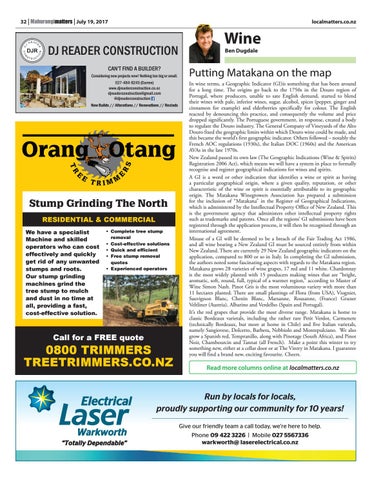cal for a fre quote
32 Mahurangimatters July 19, 2017
localmatters.co.nz
Wine
DJ READER CONSTRUCTION
080 trim ers tre trim ers.co.nz
Ben Dugdale
CAN’T FIND A BUILDER?
Putting Matakana on the map
Considering new projects now! Nothing too big or small. 027-484-8245 (Darren) www.djreaderconstruction.co.nz djreaderconstruction@gmail.com @djreaderconstruction
New Builds // Alterations // Renovations // Reclads
Stump Grinding The North Stump Grinding The North residential & commercial Stump Grinding The North
t $PNQMFUF USFF TUVNQ We haveresidential a specialist & commercial residential & commercial SFNPWBM machine and skilled t We have a specialist t $PNQMFUF USFF TUVNQ $PTU FGGFDUJWF TPMVUJPOT t Wemachine have a who specialist operators can cost $PNQMFUF USFF TUVNQ SFNPWBM and skilled t SFNPWBM 2VJDL BOE FGGJDJFOU t $PTU FGGFDUJWF TPMVUJPOT machine and skilled effectively and quickly operators who can cost t t t $PTU FGGFDUJWF TPMVUJPOT 'SFF TUVNQ SFNPWBM 2VJDL BOE FGGJDJFOU operators who can cost t 2VJDL BOE FGGJDJFOU get rid of any unwanted effectively and quickly RVPUFT t 'SFF TUVNQ SFNPWBM effectively and quickly t &YQFSJFODFE PQFSBUPST get rid of any unwanted RVPUFT stumps and roots. t 'SFF TUVNQ SFNPWBM &YQFSJFODFE PQFSBUPST getstumps rid of any unwanted t RVPUFT and roots. our stump grinding t &YQFSJFODFE PQFSBUPST our stump grinding stumps and roots. machines grind the machines grind the our stump tree stump grinding to mulch tree stump to mulch machines grind the at andand dust in in nonotime dust time at tree stump to mulch all, all, providing a afast, providing fast, and dust in no time at cost-effectivesolution. solution. cost-effective all, providing a fast, cost-effective solution. call for a free quote
call for a free quote 0800 trimmers call fortrimmers a free quote 0800
treetrimmers.co.nz 0800 trimmers treetrimmers.co.nz treetrimmers.co.nz
Electrical Warkworth “Totally Dependable�
In wine terms, a Geographic Indicator (GI)is something that has been around for a long time. The origins go back to the 1750s in the Douro region of Portugal, where producers, unable to sate English demand, started to blend their wines with pale, inferior wines, sugar, alcohol, spices (pepper, ginger and cinnamon for example) and elderberries specifically for colour. The English reacted by denouncing this practice, and consequently the volume and price dropped significantly. The Portuguese government, in response, created a body to regulate the Douro industry. The General Company of Vineyards of the Alto Douro fixed the geographic limits within which Douro wine could be made, and this became the world’s first geographic indicator. Others followed – notably the French AOC regulations (1930s), the Italian DOC (1960s) and the American AVAs in the late 1970s. New Zealand passed its own law (The Geographic Indications (Wine & Spirits) Registration 2006 Act), which means we will have a system in place to formally recognise and register geographical indications for wines and spirits. A GI is a word or other indication that identifies a wine or spirit as having a particular geographical origin, where a given quality, reputation, or other characteristic of the wine or spirit is essentially attributable to its geographic origin. The Matakana Winegrowers Association has prepared a submission for the inclusion of “Matakana� in the Register of Geographical Indications, which is administered by the Intellectual Property Office of New Zealand. This is the government agency that administers other intellectual property rights such as trademarks and patents. Once all the regions’ GI submissions have been registered through the application process, it will then be recognised through an international agreement. Misuse of a GI will be deemed to be a breach of the Fair Trading Act 1986, and all wine bearing a New Zealand GI must be sourced entirely from within New Zealand. There are currently 29 New Zealand geographic indicators on the application, compared to 800 or so in Italy. In completing the GI submission, the authors noted some fascinating aspects with regards to the Matakana region. Matakana grows 28 varieties of wine grapes, 17 red and 11 white. Chardonnay is the most widely planted with 15 producers making wines that are “bright, aromatic, soft, round, full, typical of a warmer region,� according to Master of Wine Simon Nash. Pinot Gris is the most voluminous variety with more than 11 hectares planted. There are small plantings of Flora (from USA), Viognier, Sauvignon Blanc, Chenin Blanc, Marsanne, Rousanne, (France) Gruner Veltliner (Austria), Albarino and Verdelho (Spain and Portugal). It’s the red grapes that provide the most diverse range. Matakana is home to classic Bordeaux varietals, including the rather rare Petit Verdot, Carmenere (technically Bordeaux, but more at home in Chile) and five Italian varietals, namely Sangiovese, Dolcetto, Barbera, Nebbiolo and Montepulciano. We also grow a Spanish red, Tempranillo, along with Pinotage (South Africa), and Pinot Noir, Chambourcin and Tannat (all French). Make a point this winter to try something new, either at a cellar door or at The Vintry in Matakana. I guarantee you will find a brand new, exciting favourite. Cheers.
Read more columns online at localmatters.co.nz
Run by locals for locals, proudly supporting our community for 10 years! Give our friendly team a call today, we’re here to help. Phone 09 422 3226 | Mobile 027 5567336 warkworth@ laserelectrical.co.nz
